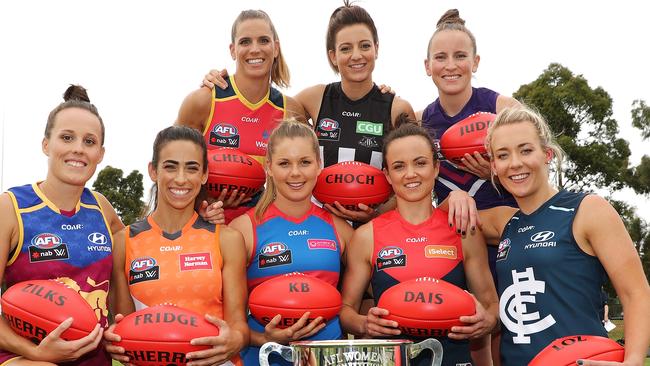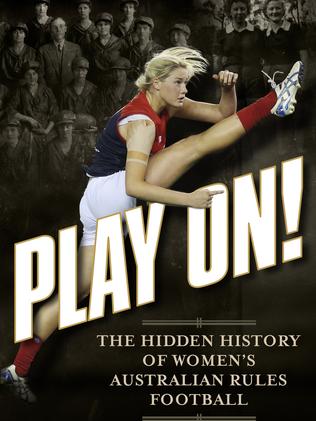AFLW: Play On! The story of the work done by female Aussie rules players to arrive at the modern competition
THE kick-off to the inaugural AFL Women’s competition is upon us, but women’s Aussie rules has a long history in this country.

THE kick-off to the inaugural AFL Women’s competition is upon us, but women’s Aussie rules has a long history in this country.
Competitions have existed in some format and at different times around the country for around 100 years and those taking the field this weekend have reaped the benefits of persistence from various female footballers throughout that time.
Play On! is a book that details the history of women’s Aussie rules in Australia, all the way back to when a female team took the field in Perth in 1917.
The following is an extract that tells of the development of the recent formalisation of women’s leagues.
THE MODERN COMPETITION
THE messages of women’s liberation were reverberating around the world and resonating in female consciousness.
Feminism’s first wave in the late 19th and early 20th century had largely been the push for voting rights.
The second wave in the 1960s and 1970s looked to secure equal rights in job opportunities and pay scales and to liberate women from the idea that their only important roles were as wives and mothers.
One of those no longer prepared to be patient in the late 1970s was the co-founder of the Victorian Women’s Football League (VWFL) and its first president, Gemma Griffiths.
“Around that time feminism was practically all we talked about,” she said. “I was a great believer in women’s liberation. It certainly raised a lot of questions for me: Why was it that men got to play footy but not women when it was so much fun? Why was it that men’s lives seemed to be so much more fun than women’s lives and so much freer? Why did they get all the glory in life?”
Griffiths and her Broadmeadows Scorpions teammate Leslie Fraser, both music teachers, were the forces behind the league.
Fraser, an American, was an unlikely champion for women’s right to play the national sport but Griffiths had a rich footballing pedigree.
Two of her great-uncles had been captains of Geelong during the early days of the Victorian Football League.

She had gone to the footy every week with her grandfather and great-uncles.
“I thought: ‘What a great game!’ I really wanted to know what it would be like to actually play.
“When I was about 17 or 18, I used to question why women were so excluded.”
Her chance came after she met Fraser at a teachers’ in-service and heard her talking about playing football. She joined Fraser’s team, the Broadmeadows Scorpions.
The ad hoc women’s competition around at the time lacked structure.
She and Leslie Fraser officially began their campaign in November 1980, with Fraser sending a letter to J.C. (Jack) Hamilton, the general manager of the Victorian Football League (VFL), seeking assistance.
His reply, dated 4 December, opened with ‘Dear Ms Fraser’ and stated: ‘I would be happy to discuss the question of your football competition’. He did, however, express reservations about offering assistance to ‘open age girls’ football’ as opposed to schoolgirl competition.
Griffiths also enlisted the help of Christine Johnson, the then equal opportunities officer at Princes Hill High School, and a great enthusiast for women’s rights.
The school figured in the foundation of the women’s league in other ways, providing a venue for meetings, as well as many schoolgirl players for one of the inaugural league sides.
The league proceeded quickly from that inaugural meeting and a four-team competition began just five weeks later, on 31 May, involving the Broadmeadows Scorpions, Hallam Cobras, Epping Blues and Princes Hill Dodgers.
The formative years of the league were dominated by the Broadmeadows Scorpions on and off the field. The club won its second premiership in 1982.
An evocative and witty article by freelance writer Virginia Adrian gives a good idea of the mood of the times.

She tells of training and playing on a school oval alongside a railway line, with passing trains sometimes slowing ‘to walking pace’ to allow passengers to witness the novelty.
Her summation of the basic playing conditions evokes the down-to-earth nature of a sport scrabbling to develop and gain a foothold on the sporting landscape:
“We were valiant and keen, but the [Hurstbridge] Warriors were pretty well the whipping girls of the competition. We ventured with trepidation to desolate ovals in distant outer suburbs for bruising encounters with fierce big girls. It was rumoured that some of them sharpened their nails into points before games.
“We changed in draughty tin sheds without showers, scratched for funds to buy jumpers and even socks, debated the delicate matter of ‘chest protection’, and did our own strapping. If you weren’t actually on the field you ran the boundary.
“In those early days, skill levels depended largely on how much kick-to-kick you had played as a kid. Girls with a tribe of brothers or boys-next-door had a big advantage; girls from large Catholic families often excelled.”
Women footballers were also starting to consider the possibility of closer bonds.
The first known interstate game involved players from Victoria and Tasmania in 1959, but it was not until Victoria and WA had both set up their own leagues that the idea was revived on a larger, more formal scale.
Having established the WAWFL, [Joanne] Huggins was quoted in several newspaper articles suggesting challenge matches against the Victorians were being considered.
In fact, the Victorians found opponents closer to home for the first unofficial state match, travelling to Adelaide in 1990 to play against South Australians.

The goal of the event was to encourage interest in women’s football in Adelaide. The initiative succeeded, with the South Australian Women’s Football League (SAWFL) being established the following year.
National carnivals would follow. Before 2000, other states sent teams to the carnivals — and sometimes hosted them — but the NT, Queensland, and Tasmania only set up official women’s leagues in the first decade of the new millennium.
NSW was the fourth state to set up a women’s league, becoming incorporated in 1999.
Play On! The Hidden History of Women’s Australian rules football is published by Echo Publishing and retails for $32.95. It can be found at all bookstores and from Booktopia.
Originally published as AFLW: Play On! The story of the work done by female Aussie rules players to arrive at the modern competition



